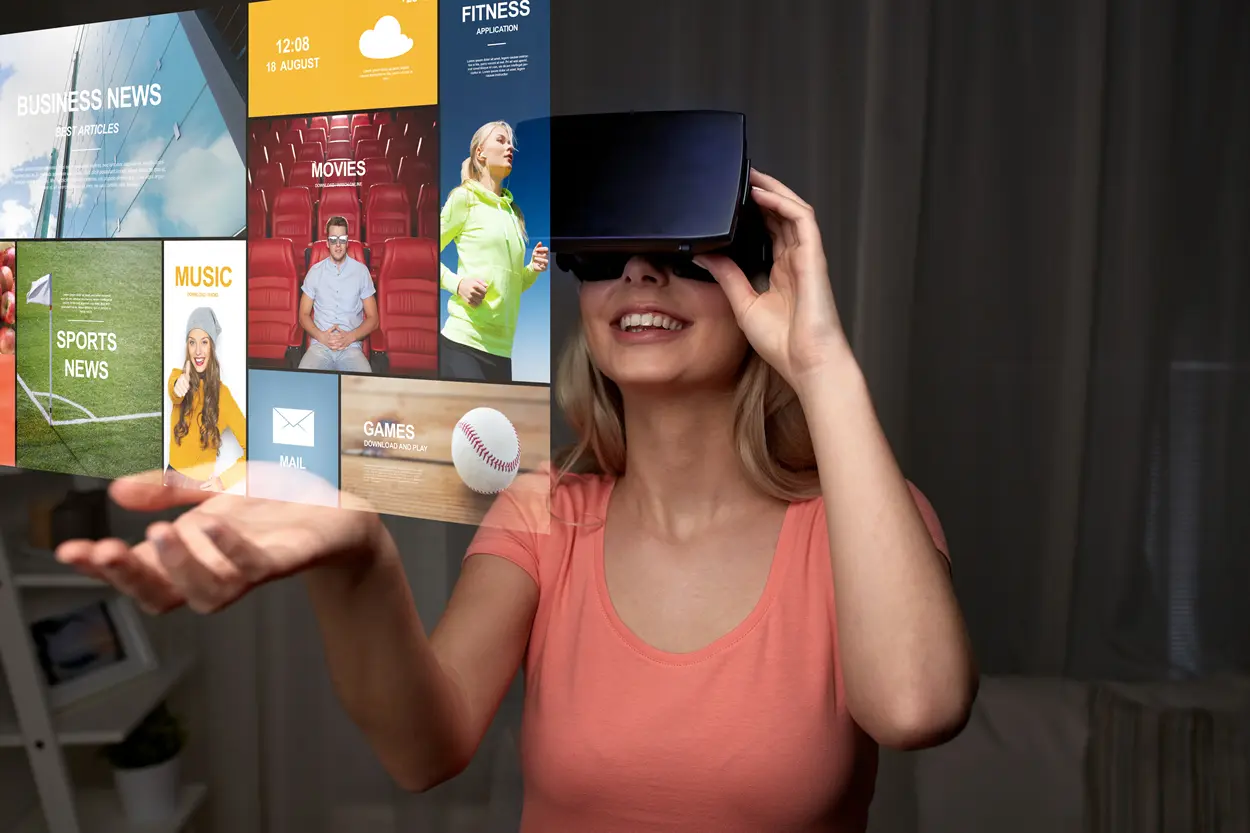In the world of announcements, augmented reality advertising (AR) is changing the way brands interact with customers. With this cutting-edge technology, the digital and physical worlds merge into one, creating a whole new world that will captivate audiences like never before. It also draws inspiration from the future of augmented reality advertising.
Table of Contents
AR’s Skyrocketing Rise and Future Looking Ahead
Once a futuristic idea, augmented reality has now become an accessible marketing behemoth. As more advanced AR tools have been developed and smartphone capability has increased, we have begun to see brands turning towards AR for creating dynamic, interactive campaigns. Given the huge strides AR technology has taken over the past few years, this could mean an era of advertising renaissance and providing opportunities never before tried.
2024 : Why is this the year for AR in marketing?
2024 is the year of AR in marketing. Augmented reality is increasingly becoming relevant to what consumers prefer to see and experience, as we all crave personalizations; AR is the ideal option. And when you combine all of those qualities with high-speed internet and software that’s 15-20 years more advanced than it used to be—never mind a very tech-savvy end consumer—there are open paths in retail for shoppers to try this stuff out. In 2019, we are likely to see a surge of innovative augmented reality campaigns that break through the clutter of traditional advertising.
Immersive experiences are on the rise.
The appeal of AR lies in its ability to create more immersive experiences. AR embeds digital into the real world, which makes it a multimodal experience that lets companies interact with customers at a more personal level—whether through sound, gifs, or even smells. It makes passive viewers active participants and helps them build a connection between brands and their audience.
Creating great AR campaigns calls for a sweet combo of creativity, tech skills, and knowing what makes people tick. Brands gotta gaze beyond the screen to cook up experiences that aren’t just eye candy but also madly interactive and memorable, ya dig? Peep into the psychology of immersion to tap into augmented reality’s power to pump up brand loyalty.
Why Consumers Get Hyped Over Augmented Reality Advertising
Immersion’s a strong psychological hook, and Ar capitalizes on this by giving users a feeling of being there and actively involved, making them feel like VIPs in the action. This deep engagement sparks emotional reactions, improves memory storage, and ultimately influences what consumers buy.
Personalized to the Max
AR slays at serving up tailored experiences. Brands can harness user data to create custom AR ads that resonate with individuals. This hyper-personalization amplifies brand love and loyalty by capturing audience attention and fortifying connections.
Creating great AR campaigns calls for a sweet combo of creativity, tech skills, and knowing what makes people tick. Brands gotta gaze beyond the screen to cook up experiences that aren’t just eye candy but also madly interactive and memorable, ya dig? Peep into the psychology of immersion to tap into augmented reality’s power to pump up brand loyalty.
Why Consumers Get Hyped Over Augmented Reality
Immersion’s a strong psychological hook, and Ar capitalizes on this by giving users a feeling of being there and actively involved, making them feel like VIPs in the action. This deep engagement sparks emotional reactions, improves memory storage, and ultimately influences what consumers buy.
AR excels at creating tailored experiences. Brands can use user data to create personalized AR ads that appeal to individuals. This hyperpersonalization boosts brand love and loyalty by capturing audience attention and strengthening connections.
Augmented reality (AR) is changing how people shop, both online and in physical stores. By blending digital enhancements with the real-world environment, AR creates immersive experiences that engage customers.
Creating personalized AR ads for individuals
One example is virtual try-on technology in fashion retail. Instead of guessing if an outfit will look good, shoppers can see themselves wearing the clothes thanks to AR mirrors. This builds confidence to purchase pieces that previously would have stayed on the rack.
Interactive AR displays also bring products to life. Customers can view all angles of a product, see special features up close, and get extra information to inform their buying choice. For instance, furniture shops are using AR, so you can envision that couch in your living room before lugging it home.
Data-Driven Delight: Using Analytics for Hyper-Personalization
The key advantage of in-store AR is that it bridges the online and offline worlds. Retailers boost sales by improving visualization, personalization, and certainty. And customers feel more enthused by the futuristic tech interaction. It’s a win-win in terms of connecting digital convenience with the tangible shopping experience.
The possibilities abound for AR retail innovations. As technology advances, so will creative implementations that customize recommendations and bring products straight off the shelves into virtual simulations. Retailers who embrace AR early will have a distinct competitive edge in satisfying digitally-savvy buyers.
Augmented Reality: E-Commerce Storefronts.
E-commerce, with the help of AR, is getting transfigured. Customers can have an experience of shopping on the internet as well as by touching and feeling something at a retail shop through virtual storefronts, which provide a 3D online shopping enclosure.
Augmented Reality Product Previews: Shop Before You Drop
With AR-promoted product previews, one can watch out for items before they purchase them on the web. These visualizations all help when customers want to make better decisions, as well as reduce the number of returns, which leads to satisfaction.
AR and Online Shopping Trust
The businesses use AR technology as it helps them offer rational factors that may apply to earning trust in the case of online shopping. A Quality content may showcase a wide range of products along with their functionalities and engagement features, promoting confidence in the buyer and then trusting the seller.
Making AR Fun for Gamification and a Light-Hearted Audience
AR took the gamification work done in advertising to the next level. Brands may incorporate in their campaigns an AR game-type experience to create captivation based but fun engagements to engage playful consumer shoppers.
Problems versus Opportunities in AR Advertising
With the massive opportunities augmented reality (AR) brings, there are also some problems that come with it. For businesses to successfully leverage this technology, these challenges need to be addressed.
Technology Limitations: Breaking Hardware and Software Boundaries
Technology limitations are one of the major problems tied to AR advertising. Providing multiple device and platform compatibility takes strong technology and smooth integration. These boundaries need to be broken when providing a consistent and engaging AR experience.
Privacy Concerns: Navigating Through Data Safety in AR Marketing
Augmented reality advertising may be severely impacted by data safety. Personalization will collect customer data on privacy and data protection. Addressing these concerns is of utmost importance to retain customer trust and to abide by legal requirements.
AR Advertising: What’s the Next Big Thing?
AR advertising has a long future. As technology improves, AR will become more intelligent and play a major role in marketing.
Beyond 2024: Predicting Long-Term Trends
Additionally, it will also predict that by 2024, AR will be more integrated into our daily lives. Long-term trends in augmented and interactive advertising will be driven by technological AR advancements as well as increasing consumer adoption.
The Influence of AI: AR with Artificial Intelligence
Furthermore, artificial intelligence will be another key component in the future of AR advertising. By enabling real-time personalization, advanced analytics, and better interaction capabilities, AI can upgrade any augmented reality advertising experience, thus making campaigns better or more engaging for users.
Summary: Surf on the AR wave.
In this context, it seems pretty obvious that this technology on the verge of revolutionizing the advertising universe is altering the mode in which it functions. Those sectors that opt to adopt augmented reality in their marketing mix will be the innovators of a new revolution in understanding consumers through their universally compelling and consumer-oriented experiences.
Things to remember, Despite all of these, there are some things that marketers need to know about video advertising.
Marketing people should know the basics of the environment and capacity of AR in the advertising field. It is critically important to apply and integrate more compelling, data-oriented, and technically and privately feasible ways to integrate AR campaigns.
On the other side, the AR ad campaign can be started with a low budget, and hence, it does not affect the business to a large extent if the ad campaign is not successful on the first try.



